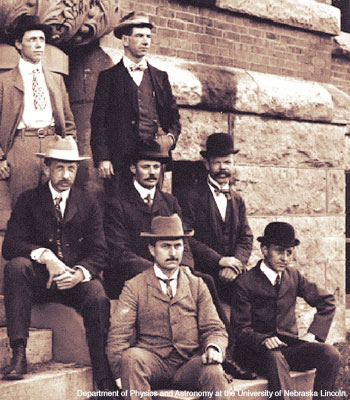The History of OSA
Brace, Skinner and Tuckerman: Optics in the Heartland
In the late 1800s, the University of Nebraska became the first school west of the Mississippi to award a doctoral degree. It also gave optics three bright stars and early leaders.
 University of Nebraska physics department, May 1905. Left to right, Front row: Burton Evans Moore and Bertram Spencer. Middle row: DeWitt Brace, John Almy and J.M. Chowins. Back row: Clarence A. Skinner and an unidentified man.
University of Nebraska physics department, May 1905. Left to right, Front row: Burton Evans Moore and Bertram Spencer. Middle row: DeWitt Brace, John Almy and J.M. Chowins. Back row: Clarence A. Skinner and an unidentified man.
The University of Nebraska opened its doors in 1871. Its first physics teacher was a Lutheran minister by the name of Samuel Aughey, who had once worked at the Smithsonian under Joseph Henry. He taught all the courses in chemistry, physics, astronomy, botany and geology, and even a course in German. As the university grew, several scholars were added to the faculty, including DeWitt Bristol Brace, who came to Nebraska in 1887. Brace had a degree from MIT, and he had done some graduate work at Johns Hopkins with Henry Rowland. He had finished a Ph.D. at Berlin, working under Helmholtz and Kirchhoff. During a one-year trial period, he taught six physics courses in addition to supervising the physics laboratories. At the end of the year, he was made a full professor and chair of the physics department.
…Log in or become a member to view the full text of this article.
This article may be available for purchase via the search at Optica Publishing Group.
Optica Members get the full text of Optics & Photonics News, plus a variety of other member benefits.
